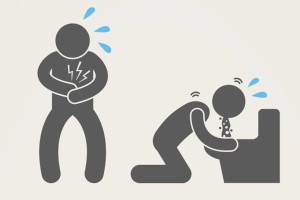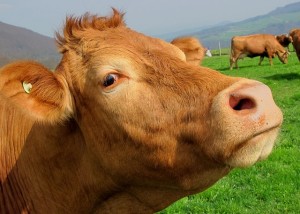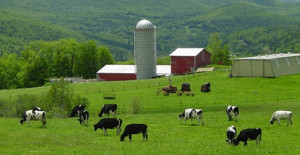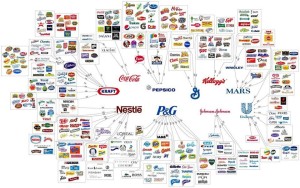Shouldn’t we make sure the food we eat is safe?
John Carino
The burger you ate today is not as safe as you assumed when you bought it. Everybody knows that cows eat grass, but it is less known that the cows whose meat most grocery stores sell, were raised eating corn. This seems like it would not be much of an issue if it weren’t for the fact that this diet increases the likeliness of spreading dangers such as E-coli. Food plays a vital role in our daily lives. Without it we cannot survive, so shouldn’t it be a priority to make sure that what we eat is safe?
American food has become industrialized to meet the needs of consumers across the country. However, this resulting industrialization has begun to lean more towards the “industry” than “food” in the food industry. Companies have begun cutting corners to maximize production and profits. Consequently, the quality of food being produced has decreased drastically causing many problems. While promoting public awareness about issues in the industrial food system is important, there needs to be a more significant movement towards instigating change in the industrial food system and improving government regulation of the industry. These changes would include more transparency of food production to consumers and preventing money –saving “shortcuts”, for example by feeding animals what nature intended for them. These operations create a safer well-being for Americans from issues such as food borne illnesses and diseases.
One reason that there have not been significant safety improvements in the food industry is because of the government’s lack of involvement in making sure these companies are not taking shortcuts. In “You are what they eat” the writer shares “our investigation raises concerns that the federal government isn’t doing enough to protect the feed supply and that as a result, the food we eat may not be as safe as it could be.” (26) Understandably, the government is not capable of regulating all food manufacturers at all times because “the FDA can’t blanket the country with inspectors, so it delegates much enforcement responsibility to the states, which conduct 70 percent of feed-company and renderer inspections.” (27) This delegation of regulation has resulted in a significant loss of control from the government. States are often less likely to take a stand against these industries than the federal government for a couple reasons. They are less likely partly because of the importance of profits these companies makes as well as because of the control these powerful companies may have over more local governments. These companies have simple goals, “to fatten animals as fast and cheaply as possible.” (26) The problem with this having this goal and finding loopholes is the compromise of quality and safety, putting consumers as risk. These “regulatory loop-holes could allow mad cow infection, if present, to make its way into cattle feed; drugs used in chickens could raise human exposure to arsenic or antibiotic-resistant bacteria; farmed fish could harbor PCBs and dioxins.” (26) The federal government needs to take a stand and instigate firmer regulation, even if it compromises fiscal profits. The more powerful these companies become the less ability the government will have to make sure the food consumers buy is safe. Consumers have very little power in fighting these food industries, they cannot simply stop buying food. That is why it is important that the government plays a big role in standing up making sure they stop hurting their consumers.
Not only is the food consumers buy not always safe, these companies also deceive consumers into thinking what they are buying is often healthier and more nutritious than it actually is. Blake Hurst in “Organic Illusions” shares how two contrasting studies present contradicting results to how nutritious “organic food” really is. Hurst writes “a recent study by a group of scientists at Stanford University found that the nutritional benefits of organic food have, to say the least, been oversold.” (2) The food industry heavily relies on misleading consumers to sell many products at escalated prices. Many companies that sell “organic” foods are owned by the larger conventional brands that they pretend to be competing with. This is another form of deception and sly misleading that needs to be stopped. Hurst argues “the organic farming narrative depends upon the belief that conventional farming sacrifices the present for the future, that the chemicals and fertilizers applied by conventional farmers poison the soil, and that this careless use of the unnatural will infect the things we eat and the productivity of our farms and ranches.” (3) However, this argument for the organic food industry is compromised by the studies that find no differences in nutritional value of foods after over half a century of hybrid seeds and 2 decades of genetically modified seeds. This does not necessarily mean there is no difference at all between conventional foods and organic, “the Stanford study found that organic foods were considerably less likely than conventional foods to have pesticide residues, although organic foods were higher in E.coli.” (3) It seems one bad quality has been traded for another, yet the food industry has been able to turn out higher profits from organic foods by misleading consumers with lies. Hurst shares “even if a naturally produced pesticide is less toxic than its synthetic counterpart, it may be applied at much higher rates than the comparable manmade chemical.” (7) One way to combat this and other deceptions by the food industry is to make sure they are not able to hide information to mislead consumers. This can be achieved by calling for complete transparencies within the food industry about how the food was produced and what products have been added to the product and the process. By advocating for more clear and detailed labels consumers can be significantly more informed on their decision making when purchasing food. This will also require government intervention but also consumers to take a stand.
Consumers blindly accept the lies fed to them by the food industry. Marion Nestle writes in “Resisting Food Safety” that “they accept at face value the endlessly intoned mantra of industry and government: the United States has the safest food supply in the world. Whether this assertion is true is a matter of some debate.” (27) The food industry has become more and more powerful and continues to fight and beat the government in every attempt to regulate their processes. Nestle presents that “food producers resist the attempts of government agencies to institute control measures, and major food industries oppose pathogen control measures by every means at their disposal. They lobby Congress and federal agencies, challenge regulations in court, and encourage local obstruction of safety enforcement.” (27-28) Not only do they fight against the government, but also heavily against activists who are fighting for their right for safer foods. An article by the US News Health shares “The food industry works aggressively to discredit its critics. According to the 2008 JAMA article, the Center for Consumer Freedom boasts “[our strategy] is to shoot the messenger. We’ve got to attack [activists’] credibility as spokespersons.” The website even revers to Nestle as “one of the country’s most hysterical anti-food fanatics.” It seems difficult to combat an industry with so much financial, political, and publicity power, but it is not impossible.
By creating a more transparent food industry and instigating stricter regulation, the food industry could return to serving a primary purpose of meeting the needs and safety of consumers, not just to churn our profits and mass produce products. One small step at a time of making the right decisions in making food safe will have a significant impact on creating a safer America. It will take time effort from much of the population, but it is not an unreachable goal, and with the safety of millions of Americans at stake, it is necessary.
Works Cited:
“You Are What They Eat.” Consumer Reports, January 2005.
Hurst, Blake. “Organic Illusions.” The American, October 1, 2012.
Nestle, Marion. Safe Food: The Politics of Food Safety. Berkeley: University of California Press, 2010.
Voiland, Adam, and Angela Haupt. “10 Things the Food Industry Doesn’t Want You to Know.” Health.usnews.com. March 30, 2012.
Reflection Questions
- Describe your understanding of the “writer’s project”? How were you able to identify the texts’ “project”? Discuss your own “project” as it pertains to this particular blog article.
-Finding the “writer’s project” is key to understanding the argument and greater point of any source or project. From the examples we went over I was able to find the writers project by studying the evidence they presented and analyzing their arguments to find what point they were trying to make. For example, in the Kanye West music video studying the imagery used and listening closely to the lyrics allowed me to figure out what he was trying to make clear. My “project” with this blog article was to present the biggest issues with the food industry today and suggest possible solutions that could be considered to instigate change.
- Describe your completion of the “Sorting it Out” workshop? What sections were most beneficial to the development of your ideas—and why? Discuss how this workshop assisted in development of draft and/or assignment organization?
-The most beneficial section from this worksheet was anaylizing the main argument that each article/report was trying to make. By figuring out what each source had to offer specifically helped create a stronger thesis that consisted of a few key arguments. This workshop allowed me to clearly brainstorm and build on my ideas in a cohesive way, by initially forcing me to find out the key concepts then by finding specific evidence from the text that supported them.
3.) Describe your understanding of synthesis. What is its importance? How did it manifest within your drafts and/or final blog article? Provide examples.
-Synthesis is key when attempting to make a clear argument. If you are trying to make an argument and your evidence does not relate to your argument or at all to other evidence your claim will seem weak and unsupported. I synthezised the main arguments from each source to support my thesis of how America needs to instigate change in the food industry. I also utilized my outside source to support the evidence from the other articles. For example, the article I used comments on how Marion Nestle is viewed by the food industry as “one of the country’s most hysterical anti-food fanatics.”
4.) Describe your own accomplishment (of something) during this unit.
-During this unit I feel there were a few skills I familiarized myself with that I was new too. I have never attempted to write I a “blog/article” format before. This required me to learn a few new skills and writing techniques.
5.) Discuss the evolution of the main idea. Where did you begin (include the example) and show its progress (again, include example) throughout the drafting/revision process. To what do you attribute its evolution?
-My main idea evolved as I gained more evidence exploring the articles/sources in more depth. What began as an unsupported claim vilifying the food industry became a well-supported argumentative piece that begins to even offer solutions to the issues presented. For example, I was initially aware that the food industry mislead consumers, but by further examining the given texts I was able to prove how they do so through false claims and misunderstanding on terminology such as “organic.”
6.) Discuss what organizational strategies you implemented in order to structure this blog article. Provide examples from a section(s) of an earlier draft and other excerpts in later drafts to support your response.
-To structure this blog article I considered how a person hopes to consume information. I lead with a catchy introduction to grab their attention, present the topics I intend to discuss, then present an open ended question that my arguments throughout the blog support. In an earlier draft I had written out the topics I intended to discuss in an outline including: How the government needs to step up, how the food industry deceives, and how the food industry is fighting anyone that tries to oppose it. My arguments against these points answer the question I pose of “shouldn’t it be a priority to make sure that what we eat is safe?”
7.) Provide an example of the final draft where you successfully synthesize 3 texts in a concise and direct manner. Discuss how this evolved throughout the drafting process for you.
-In my conclusion I connect the main arguments from each text to suggest what actions could be made to create a positive future for American food safety. I proose “By creating a more transparent food industry and instigating stricter regulation, the food industry could return to serving a primary purpose of meeting the needs and safety of consumers, not just to churn our profits and mass produce products.” Through the drafting process I was not as sure what proposals I could make about how to fix these issues but further analysis of the texts led me to this argument.
8.) Discuss the evolution of the ‘lede’ in earlier drafts and its final version (provide examples of each): where did you begin, what feedback did you receive, and how did it end up in final blog article?
-My original lede was not significantly different from my final blog. The tips from the worksheet we went over in class were helpful to simplify and reinforce the lede I had written.
9.) Name a specific writing/researching/revision goal you’d like to work on during the next Unit projects.
-I would like to figure out how to narrow down my arguments into a more precise response. I often use too many works and by figuring out how to share my ideas more clearly I will be able to write more convincing works of writing.















